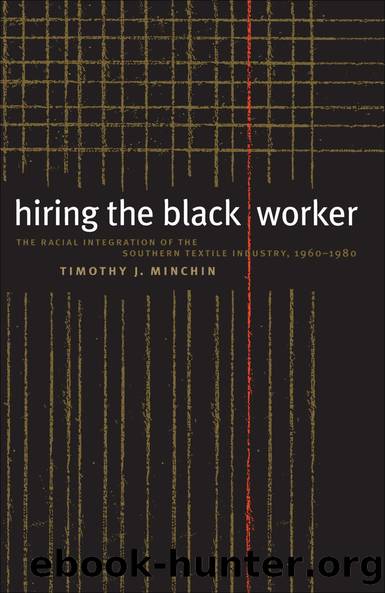Hiring the Black Worker by Timothy J. Minchin

Author:Timothy J. Minchin [Minchin, Timothy J.]
Language: eng
Format: epub
Tags: History, African American & Black, Business & Economics, Labor, General, United States, 20th Century
ISBN: 9780807882931
Google: j5Lrzd-sBYwC
Publisher: UNC Press Books
Published: 2013-01-01T04:01:08+00:00
The Experiences of African American Women in the Textile Industry
Although black women still faced considerable hiring discrimination in the 1960s and 1970s, they also began to enter production jobs in the industry in increasing numbers. Several large textile companies began to hire African American women in much greater numbers, opening up certain production positions that had previously been the domain of white women. Although the opportunities available to black women did not match their demand for textile work, the opening of some production positions was significant because of the traditional exclusion of black women from the industry. Indeed, the history of complete exclusion of black women from production jobs meant that even a small amount of hiring produced massive percentage increases. At J. P. Stevensâs plants in Roanoke Rapids, North Carolina, for example, the Sledge case revealed that black women made significant progress into production jobs in the late 1960s. In mid-May of 1969, only 6 of Stevensâs 120 female spinners were black. From this date until June 30, 1972, however, Stevens hired and assigned 45 women to the job of spinner, 22 of them black. In the same period, 40 black women out of a total of 116 assigned to the job of weaver were black, even though the weaver position had previously been only 1.9 percent black.60 Similarly, the Adams case established that Dan River Mills had begun to assign many black women to the high-paying production job of weaver in the late 1960s, although few black men were given the same opportunity (see table 16).
By the late 1960s, black women were making more progress into some better-paying jobs than their male counterparts. As a result, data produced in a variety of lawsuits showed that pay disparities for black women were continually declining in the late 1960s and early 1970s, at the same time that they were static or increasing for black men. An analysis of pay disparities at Dan River Mills, for example, showed that there was a ânoticeable declineâ in the wage disparity between white and black females between 1969 and 1973, while at the same time the disparities between white and black males remained constant.61 Similarly, in Sledge v. J. P. Stevens, a data analysis conducted in 1980 found that pay disparities were increasing between men but were decreasing among women.62
Table 16. Assignment of New Hires to the Weaver Job by Race and Sex at Dan River Mills, January 1, 1969âMarch 31, 1971
Download
This site does not store any files on its server. We only index and link to content provided by other sites. Please contact the content providers to delete copyright contents if any and email us, we'll remove relevant links or contents immediately.
The Social Psychology of Inequality by Unknown(2313)
The Plant Paradox by Dr. Steven R. Gundry M.D(2048)
The Writing on the Wall by Anselm Jappe(1762)
Working for Yourself by J.D. (Nolo) Stephen Fishman(1480)
Every Landlord's Legal Guide by Janet Portman & Stewart Marcia & Ralph Warner(1329)
The First 20 Hours: How to Learn Anything ... Fast by Kaufman Josh(1309)
ADHD on Trial by Michael Gordon(1243)
Decisive by Chip Heath(1202)
Drafting Contracts: How and Why Lawyers Do What They Do, Second Edition by Stark Tina L(1175)
Working for Yourself by Stephen Fishman J.D. (Nolo)(1141)
The Economist Aug 8th 2015 by The Economist(1124)
Restitution by Restitution(1116)
The Economist Aug 29th 2015 by The Economist(1099)
A Practical Guide to International Arbitration in London by Hilary Heilbron(1085)
The Lord of the Rings: The Fellowship of the Ring, the Two Towers, the Return of the King by J. R. R. Tolkien(1084)
Intellectual Property Strategy by John Palfrey(1083)
Collusion by Luke Harding(1046)
Persuasion by Owner(1018)
Chapter 1 by Owner(953)
